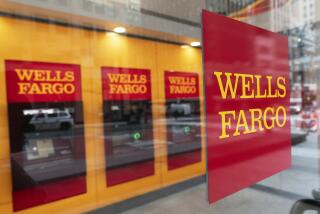Wells Fargo agrees to pay $480 million to settle securities-fraud lawsuit over fake accounts
- Share via
Wells Fargo & Co. said Friday that it had agreed to pay $480 million to settle a class-action lawsuit accusing the banking giant of securities fraud related to the fake-accounts scandal that has rocked the company since 2016.
The San Francisco-based bank denied the allegations but said it had “entered into the agreement in principle to avoid the cost and disruption of further litigation.”
“We are making strong progress in our work to rebuild trust, and this represents another step forward,” Wells Fargo Chief Executive Tim Sloan said in a statement.
Wells Fargo said it already had set aside reserves to pay for the settlement, which is subject to approval by the court. In the fourth quarter, the bank took a $3.25-billion charge against earnings to settle what it called “a variety of matters, including mortgage-related regulatory investigations, sales practices, and other consumer-related matters.”
The suit stemmed from the scandal over Wells Fargo’s aggressive “cross-selling efforts,” in which employees created millions of new accounts in customers’ names without their consent, such as new credit card accounts.
The tactics were first uncovered by the Los Angeles Times in 2013, and the scandal mushroomed in September 2016 when Wells Fargo agreed to pay $185 million to settle investigations by the Consumer Financial Protection Bureau, the Office of the Comptroller of the Currency and L.A. City Atty. Mike Feuer.
In the class action suit filed with the U.S. District Court in San Francisco, the investors claimed that Wells Fargo “knew but deliberately failed to disclose known material true facts” about its actions, including “that the company’s cross-selling strategy was not focused on or designed to benefit customers.”
Rather, the effort was “designed to fulfill sales quotes or otherwise advance the interests of Wells Fargo or its employees and increase sources of profitability while simultaneously burdening customers with financial products they did not authorize, need and/or even know about,” the suit claimed.
That scenario resulted in Wells Fargo’s stock trading at “artificially inflated prices,” the suit claimed.
The suit was brought on behalf of investors who bought Wells Fargo’s stock between Feb. 26, 2014, and Sept. 15, 2016, one week after the bank reported its $185-million settlement, which caused the stock’s drop in value. The court-appointed lead plaintiff in the case was Union Investment, a European asset-management firm.
“We are pleased that with this settlement, Wells Fargo is taking an important step towards reckoning with its prior mistakes and focusing on creating value for its investors while acting with integrity,” Andreas Zubrod, a Union Investment executive board member, said in a statement.
“Fabricating customer accounts and then concealing how those fake accounts impacted cross-sell metrics is simply unacceptable and undermines the trust that Union Investment and other investors put in Wells Fargo’s management,” Zubrod said.
Wells Fargo still faces other lawsuits, and the settlement announced Friday is only the latest in a series of penalties and other actions that have taken a financial toll on the bank not only for the fake-accounts scandal but also for its risk-management practices overall.
Last month, federal regulators slapped Wells Fargo with a $1-billion penalty for abuses that harmed mortgage and auto-loan borrowers and for what regulators said was a pervasive and “reckless” lack of risk management.
The penalty – announced by the Office of the Comptroller of the Currency and the Consumer Financial Protection Bureau – was one of the largest fines levied against a U.S. bank that was not related to the financial crisis.
And in February, the Federal Reserve took the rare step of ordering the bank to cap its growth while it worked to improve its corporate governance for what the central bank called “widespread consumer abuses and other compliance breakdowns.”
Still, the massive bank has been able to absorb the financial hits. The bank generated profit of $22.2 billion last year and last month reported $5.9 billion in this year’s first quarter. However, the $1-billion penalty did require Wells Fargo to adjust its first-quarter results to reflect the fines, cutting profit for the first three months of the year to $4.7 billion.
Since the fake-accounts scandal exploded and other wrongdoing has come to light, the bank has changed its chief executive and chairman and seen turnover on its board. But it still must show the Fed that it has improved its governance.
Until it does that, Wells Fargo will remain under close scrutiny and will not be allowed to grow its assets beyond $1.95 trillion, where they stood at the end of last year. Sen. Elizabeth Warren (D-Mass.) has demanded that the Fed’s Board of Governors vote on any reform plan and not leave the decision to lower-level staff.
Shares of Wells Fargo gained 87 cents, or 1.7%, to $52.41 on Friday.
UPDATES:
4:15 p.m.: This article was updated with staff reporting throughout.
This article was originally published at 2:50 p.m.
More to Read
Inside the business of entertainment
The Wide Shot brings you news, analysis and insights on everything from streaming wars to production — and what it all means for the future.
You may occasionally receive promotional content from the Los Angeles Times.











